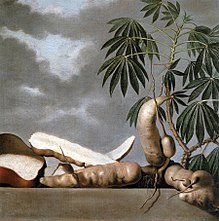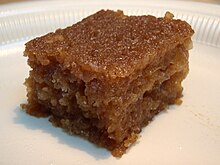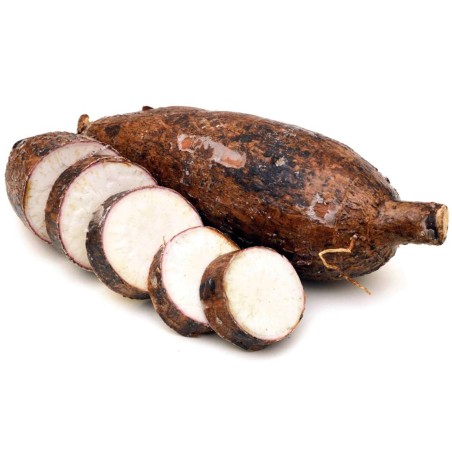
Cassava, Yuca (Manihot esculenta)
Cassava, Yuca, Macaxeira, Mandioca, Aipim Seeds (Manihot esculenta)
Price for Package of 3 seeds.
Manihot esculenta, commonly called cassava (/kəˈsɑːvə/), manioc, yuca, macaxeira, mandioca and aipim, is a woody shrub native to South America
Cassava, Yuca, Macaxeira, Mandioca, Aipim Seeds (Manihot esculenta)
Price for Package of 3 seeds.
Manihot esculenta, commonly called cassava (/kəˈsɑːvə/), manioc, yuca, macaxeira, mandioca and aipim, is a woody shrub native to South America of the spurge family, Euphorbiaceae. Although a perennial plant, cassava is extensively cultivated as an annual crop in tropical and subtropical regions for its edible starchy tuberous root, a major source of carbohydrates. Though it is often called yuca in Latin American Spanish and in the United States, it is not related to yucca, a shrub in the family Asparagaceae. Cassava is predominantly consumed in boiled form, but substantial quantities are used to extract cassava starch, called tapioca, which is used for food, animal feed, and industrial purposes. The Brazilian farinha, and the related garri of West Africa, is an edible coarse flour obtained by grating cassava roots, pressing moisture off the obtained grated pulp, and finally drying it (and roasting in the case of farinha).
Cassava is the third-largest source of food carbohydrates in the tropics, after rice and maize.[3][4] Cassava is a major staple food in the developing world, providing a basic diet for over half a billion people.[5] It is one of the most drought-tolerant crops, capable of growing on marginal soils. Nigeria is the world's largest producer of cassava, while Thailand is the largest exporter of cassava starch.
Cassava is classified as either sweet or bitter. Like other roots and tubers, both bitter and sweet varieties of cassava contain antinutritional factors and toxins, with the bitter varieties containing much larger amounts.[6] It must be properly prepared before consumption, as improper preparation of cassava can leave enough residual cyanide to cause acute cyanide intoxication,[7][8] goiters, and even ataxia, partial paralysis, or death. The more toxic varieties of cassava are a fall-back resource (a "food security crop") in times of famine or food insecurity in some places.[7][6] Farmers often prefer the bitter varieties because they deter pests, animals, and thieves.
Description
The cassava root is long and tapered, with a firm, homogeneous flesh encased in a detachable rind, about 1 mm thick, rough and brown on the outside. Commercial cultivars can be 5 to 10 cm (2.0 to 3.9 in) in diameter at the top, and around 15 to 30 cm (5.9 to 11.8 in) long. A woody vascular bundle runs along the root's axis. The flesh can be chalk-white or yellowish. Cassava roots are very rich in starch and contain small amounts of calcium (16 mg/100 g), phosphorus (27 mg/100 g), and vitamin C (20.6 mg/100 g).[10] However, they are poor in protein and other nutrients. In contrast, cassava leaves are a good source of protein (rich in lysine), but deficient in the amino acid methionine and possibly tryptophan.[11]





History

Wild populations of M. esculenta subspecies flabellifolia, shown to be the progenitor of domesticated cassava, are centered in west-central Brazil, where it was likely first domesticated no more than 10,000 years BP.[12] Forms of the modern domesticated species can also be found growing in the wild in the south of Brazil. By 4,600 BC, manioc (cassava) pollen appears in the Gulf of Mexico lowlands, at the San Andrés archaeological site.[13] The oldest direct evidence of cassava cultivation comes from a 1,400-year-old Maya site, Joya de Cerén, in El Salvador.[14] With its high food potential, it had become a staple food of the native populations of northern South America, southern Mesoamerica, and the Caribbean by the time of European contact in 1492. Cassava was a staple food of pre-Columbian peoples in the Americas and is often portrayed in indigenous art. The Moche people often depicted yuca in their ceramics.[15]
Spaniards in their early occupation of Caribbean islands did not want to eat cassava or maize, which they considered insubstantial, dangerous, and not nutritious. They much preferred foods from Spain, specifically wheat bread, olive oil, red wine, and meat, and considered maize and cassava damaging to Europeans.[16] The cultivation and consumption of cassava was nonetheless continued in both Portuguese and Spanish America. Mass production of cassava bread became the first Cuban industry established by the Spanish,[17]Ships departing to Europe from Cuban ports such as Havana, Santiago, Bayamo, and Baracoa carried goods to Spain, but sailors needed to be provisioned for the voyage. The Spanish also needed to replenish their boats with dried meat, water, fruit, and large amounts of cassava bread.[18] Sailors complained that it caused them digestive problems.[19] Tropical Cuban weather was not suitable for wheat planting and cassava would not go stale as quickly as regular bread.
Cassava was introduced to Africa by Portuguese traders from Brazil in the 16th century. Around the same period, it was also introduced to Asia through Columbian Exchange by Portuguese and Spanish traders, planted in their colonies in Goa, Malacca, Eastern Indonesia, Timor and the Philippines. Maize and cassava are now important staple foods, replacing native African crops in places such as Tanzania.[20] Cassava has also become an important staple in Asia, extensively cultivated in Indonesia, Thailand and Vietnam.[21] Cassava is sometimes described as the "bread of the tropics"[22] but should not be confused with the tropical and equatorial bread tree (Encephalartos), the breadfruit (Artocarpus altilis) or the African breadfruit (Treculia africana).
Production
In 2016, global production of cassava root was 277 million tonnes, with Nigeria as the world's largest producer having 21% of the world total (table). Other major growers were Thailand, Brazil, and Indonesia.[23]
| Cassava production – 2016 | |
|---|---|
| Country | Production (millions of tonnes) |
Cassava is one of the most drought-tolerant crops, can be successfully grown on marginal soils, and gives reasonable yields where many other crops do not grow well. Cassava is well adapted within latitudes 30° north and south of the equator, at elevations between sea level and 2,000 m (6,600 ft) above sea level, in equatorial temperatures, with rainfalls from 50 mm (2.0 in) to 5 m (16 ft) annually, and to poor soils with a pH ranging from acidic to alkaline. These conditions are common in certain parts of Africa and South America.
Cassava is a highly-productive crop when considering food calories produced per unit land area, per unit of time. Significantly higher than other staple crops, cassava can produce food calories at rates exceeding 250,000 kcal/hectare/day, as compared with 176,000 for rice, 110,000 for wheat and 200,000 for maize (corn).
Economic importance

Cassava, yams (Dioscorea spp.), and sweet potatoes (Ipomoea batatas) are important sources of food in the tropics. The cassava plant gives the third-highest yield of carbohydrates per cultivated area among crop plants, after sugarcane and sugar beets.[24] Cassava plays a particularly important role in agriculture in developing countries, especially in sub-Saharan Africa, because it does well on poor soils and with low rainfall, and because it is a perennial that can be harvested as required. Its wide harvesting window allows it to act as a famine reserve and is invaluable in managing labor schedules. It offers flexibility to resource-poor farmers because it serves as either a subsistence or a cash crop.[25]
Worldwide, 800 million people depend on cassava as their primary food staple.[26] No continent depends as much on root and tuber crops in feeding its population as does Africa. In the humid and sub-humid areas of tropical Africa, it is either a primary staple food or a secondary costaple. In Ghana, for example, cassava and yams occupy an important position in the agricultural economy and contribute about 46 percent of the agricultural gross domestic product. Cassava accounts for a daily caloric intake of 30 percent in Ghanaand is grown by nearly every farming family. The importance of cassava to many Africans is epitomised in the Ewe (a language spoken in Ghana, Togo and Benin) name for the plant, agbeli, meaning "there is life".
In Tamil Nadu, India, there are many cassava processing factories alongside National Highway 68 between Thalaivasal and Attur. Cassava is widely cultivated and eaten as a staple food in Andhra Pradesh and in Kerala. In Assam it is an important source of carbohydrates especially for natives of hilly areas.
In the subtropical region of southern China, cassava is the fifth-largest crop in term of production, after rice, sweet potato, sugar cane, and maize. China is also the largest export market for cassava produced in Vietnam and Thailand. Over 60 percent of cassava production in China is concentrated in a single province, Guangxi, averaging over seven million tonnes annually.
Uses
|
|
This section needs additional citations for verification. Please help improve this article by adding citations to reliable sources. Unsourced material may be challenged and removed.
Find sources: "Cassava" – news · newspapers · books · scholar · JSTOR (August 2017) (Learn how and when to remove this template message) |

Alcoholic beverages
Alcoholic beverages made from cassava include cauim and tiquira (Brazil), kasiri (Guyana, Suriname), impala (Mozambique), masato (Peruvian Amazonia chicha), parakari or kari (Guyana), nihamanchi (South America) also known as nijimanche (Ecuador and Peru), ö döi (chicha de yuca, Ngäbe-Bugle, Panama), sakurá (Brazil, Suriname), and tarul ko jaarh (Darjeeling, Sikkim, India).
Culinary

Cassava-based dishes are widely consumed wherever the plant is cultivated; some have regional, national, or ethnic importance.[27] Cassava must be cooked properly to detoxify it before it is eaten.
Cassava can be cooked in many ways. The root of the sweet variety has a delicate flavor and can replace potatoes. It is used in cholent in some households.[citation needed] It can be made into a flour that is used in breads, cakes and cookies. In Brazil, detoxified manioc is ground and cooked to a dry, often hard or crunchy meal known as farofa used as a condiment, toasted in butter, or eaten alone as a side dish.
Nutritional profile
| Nutritional value per 100 g (3.5 oz) | |
|---|---|
| Energy | 160 kcal (670 kJ) |
|
Carbohydrates
|
38.1 g
|
| Sugars | 1.7 g |
| Dietary fiber | 1.8 g |
|
Fat
|
0.3 g
|
|
Protein
|
1.4 g
|
| Vitamins | Quantity%DV† |
| Thiamine (B1) |
8%
0.087 mg |
| Riboflavin (B2) |
4%
0.048 mg |
| Niacin (B3) |
6%
0.854 mg |
| Vitamin B6 |
7%
0.088 mg |
| Folate (B9) |
7%
27 μg |
| Vitamin C |
25%
20.6 mg |
| Minerals | Quantity%DV† |
| Calcium |
2%
16 mg |
| Iron |
2%
0.27 mg |
| Magnesium |
6%
21 mg |
| Phosphorus |
4%
27 mg |
| Potassium |
6%
271 mg |
| Sodium |
1%
14 mg |
| Zinc |
4%
0.34 mg |
| Other constituents | Quantity |
| Water | 60 g |
Full Link to USDA Database entry
|
|
|
|
| †Percentages are roughly approximated using US recommendations for adults. | |
Raw cassava is 60% water, 38% carbohydrates, 1% protein, and has negligible fat (table).[28] In a 100 gram amount, raw cassava provides 160 calories and contains 25% of the Daily Value (DV) for vitamin C, but otherwise has no micronutrients in significant content (no values above 10% DV; table). Cooked cassava starch has a digestibility of over 75%.[28]
Cassava, like other foods, also has antinutritional and toxic factors. Of particular concern are the cyanogenic glucosides of cassava (linamarin and lotaustralin). On hydrolysis, these release hydrocyanic acid (HCN).[citation needed] The presence of cyanide in cassava is of concern for human and for animal consumption. The concentration of these antinutritional and unsafe glycosides varies considerably between varieties and also with climatic and cultural conditions. Selection of cassava species to be grown, therefore, is quite important. Once harvested, bitter cassava must be treated and prepared properly prior to human or animal consumption, while sweet cassava can be used after simply boiling.
Comparison with other major staple foods
A comparative table shows that cassava is a good energy source. In its prepared forms in which its toxic or unpleasant components have been reduced to acceptable levels, it contains an extremely high proportion of starch. Compared to most staples however, cassava accordingly is a poorer dietary source of protein and most other essential nutrients. Though an important staple, its main value is as a component of a balanced diet.
Comparisons between the nutrient content of cassava and other major staple foods when raw, as shown in the table, must be interpreted with caution because most staples are not edible in such forms and many are indigestible, even dangerously poisonous or otherwise harmful.[citation needed] For consumption, each must be prepared and cooked as appropriate. Suitably cooked or otherwise prepared, the nutritional and antinutritional contents of each of these staples is widely different from that of raw form and depends on the methods of preparation such as soaking, fermentation, sprouting, boiling, or baking.
| Organic Seeds ? | Organic Seeds |
|---|---|
| Organic/natural ? | Organic/Natural: Yes |
| Edible ? | Edible |
| Pretreatment of sowing ? | Soak in water before sowing 12-24 h |
| Sowing depth ? | Sowing depth 1 cm |
| Perennial ? | Perennial plant : Yes |
| Plant is suitable for growing ? | The plant is suitable for growing in a greenhouse The plant is suitable for outdoors cultivation |
| Suitable for growing in flower pot ? | Suitable for pot: Yes |
| Origin of seeds ? | Seeds imported from: Thailand |
| Origin Country of Variety ? | Variety from: Thailand |
| Medicinal Plant ? | Medicinal Plant: Yes |
| Scientific name: | Manihot esculenta |
| Sun Exposure ? | Full sun from an early age |
| Tree Appearance ? | Shrub |
| Growth Rate ? | Medium Growth Rate |
| Planting Time? | Planting Time: Whole year-round |
| Indoor/Outdoor? | Indoor/Outdoor: Indoor & Outdoor |
| Soil Type? | Soil Type: Any |
| Watering? | Watering: Low |
| Cultivating Difficulty? | Cultivating Difficulty: Medium |


Aprecierea ta pentru recenzie nu a putut fi trimisa
Reclama un comentariu
Raport trimis
Reclamatia tau nu a putut fi trimisa
Scrie-ti recenzia
Recenzia a fost trimisa
Recenzia ta nu a putut fi trimisa
🌍 Livrare Globală din UE
Expediem comenzi la nivel mondial din Uniunea Europeană prin poștă înregistrată cu confirmare de primire.
📦 Urmărirea coletului
Pentru a urmări coletul, autentifică-te în contul tău și accesează secțiunea Istoricul comenzilor > Detalii. Acolo vei găsi numărul de urmărire.
Urmărire internațională: 17Track
Pentru numere de tip RGxxxxxxHR: Posta.hr Tracking
🕒 Notă: Informațiile de urmărire devin disponibile după cel puțin 24 de ore de la expediere.
⚠️ Informații importante
Plata ramburs nu este disponibilă.
Verifică dosarul SPAM / Junk al e-mailului pentru a nu rata notificările.
Contactează-ne doar prin formularul de contact de pe site.
E-mailurile directe nu vor fi procesate.
📱 Număr de telefon obligatoriu
La plasarea comenzii, te rugăm să introduci numărul tău de telefon mobil cu prefixul internațional al țării.
Exemplu: +40 712 345 678
🚚 Condiții de livrare
Pentru coletele înregistrate, este necesară semnătura destinatarului.
Nu comanda dacă:
dorești ca pachetul să fie livrat într-o cutie poștală
nu vei fi acasă pentru a-l prelua
dorești ca pachetul să fie lăsat la un vecin (❌ acest lucru nu este posibil)
📬 Dacă oferi o adresă de tip cutie poștală și coletul se pierde, nu ai dreptul la ramburs.
↩️ Returnarea coletului și reexpediere
Dacă, din orice motiv, coletul este returnat către noi:
Vei fi responsabil pentru costul de retur de 2 €
Și pentru costul reexpedierii
⏱ Întârzieri și urmărire
Dacă urmărirea indică „la expeditor”, înseamnă că este în tranzit.
Contactează oficiul poștal local cu numărul de urmărire pentru informații actualizate.
Nu suntem serviciu poștal – nu putem urmări coletul în numele tău.
Nu ne asumăm responsabilitatea pentru timpii de livrare.
🔍 Putem începe o investigație doar după 30 de zile de la data expedierii.
✈️ Opțiuni de livrare
| Tip livrare | Timp procesare | Asigurare | Posibile întârzieri | Detalii |
|---|---|---|---|---|
| Standard | 7–10 zile lucrătoare | ❌ | 7–14 zile | Cea mai ieftină opțiune |
| Prioritară | 1–7 zile lucrătoare | ❌ | 3–10 zile | Comanda procesată prioritar, dar nu livrată mai rapid |
| Asigurată | 1–7 zile lucrătoare | ✅ | 3–10 zile | Rambursare garantată dacă coletul se pierde (până la 150 €) |
🕒 Timp estimativ de livrare:
În UE: 3–20 zile lucrătoare
Internațional: 5–30 zile lucrătoare
Exemple livrări SUA: 27, 22, 19, 17, 13 zile
💳 Metode de plată
💶 Transfer bancar (SEPA / IBAN / SWIFT-BIC)
În descrierea plății trebuie să menționezi codul comenzii (ex. SGS-19811702).
Dacă nu apare codul, comanda poate întârzia sau fi anulată.
Dacă plata nu este recepționată în 7 zile, comanda va fi anulată automat.
🅿️ PayPal
Acceptăm plăți doar în euro.
Te rugăm să selectezi euro în timpul procesului de plată.
💳 Card bancar
Plata se face pe site-ul nostru: Exotic Seeds Store
Acceptăm: Visa, MasterCard, American Express, Diners Club, Discover, JCB, UnionPay etc.
💡 Clientul suportă toate taxele de tranzacție.
Pentru procesare rapidă, trimite dovada plății.
📅 Observații suplimentare
Nu procesăm comenzi și nu expediem sâmbăta sau duminica.
Verifică întotdeauna anunțurile importante de pe site-ul nostru înainte de a plasa o comandă (ex. sărbători sau condiții speciale).
📫 Important:
Nu trimite mesaje pe adresa noastră de e-mail. Folosește exclusiv formularul de contact disponibil pe site-ul nostru.
Related Products



















